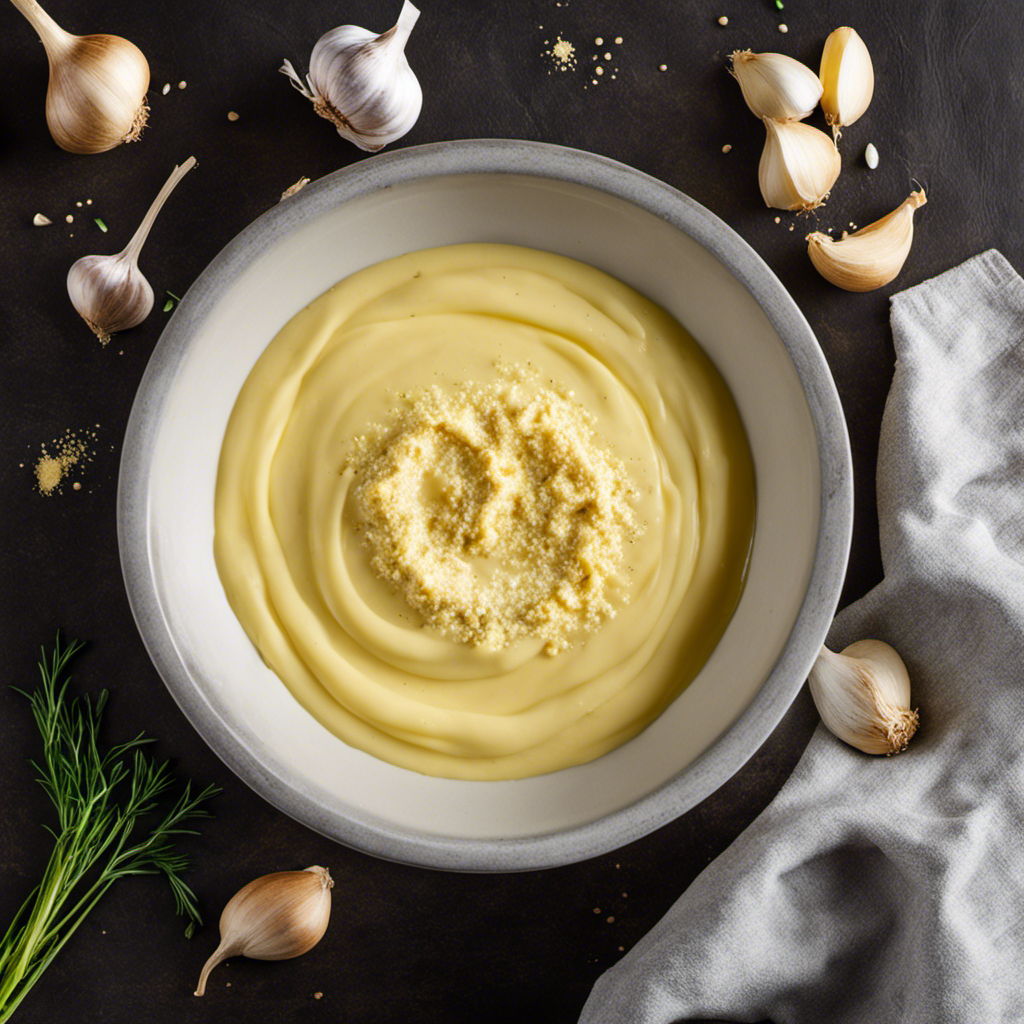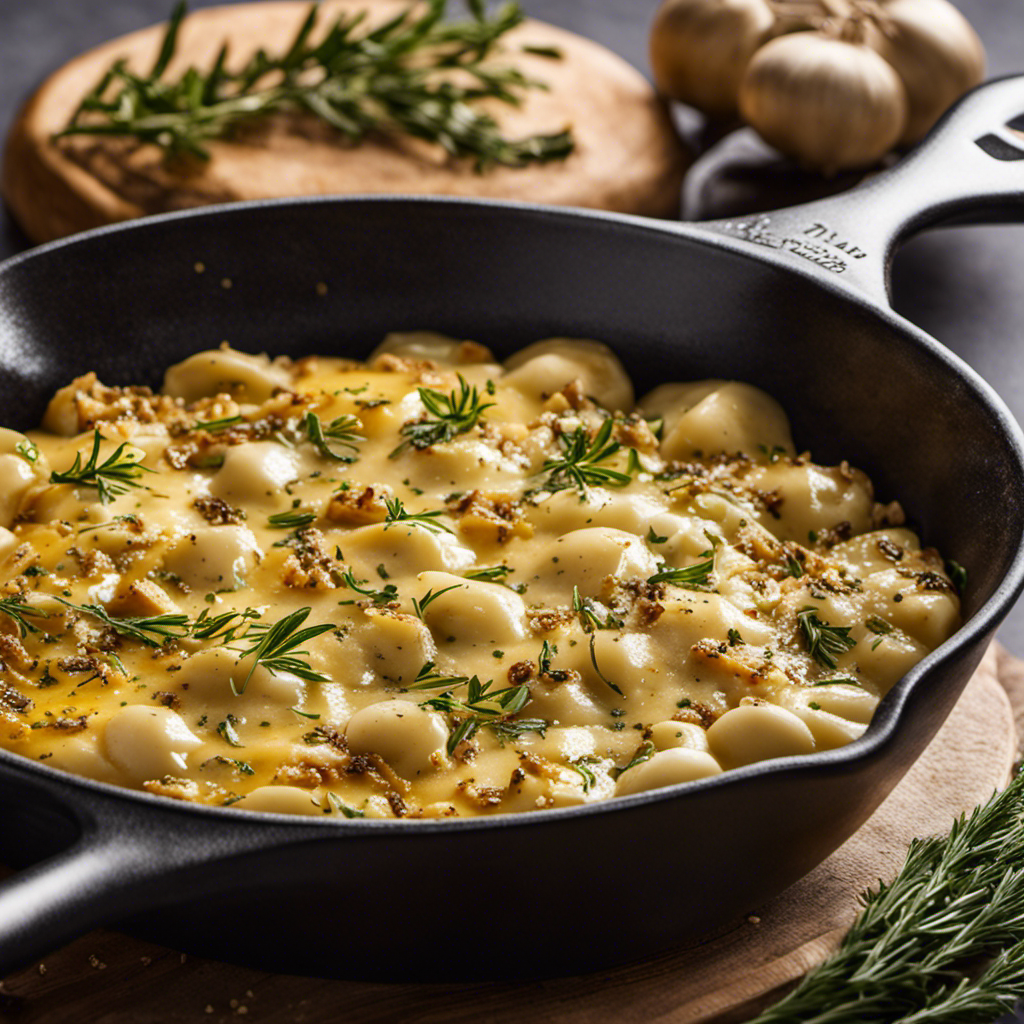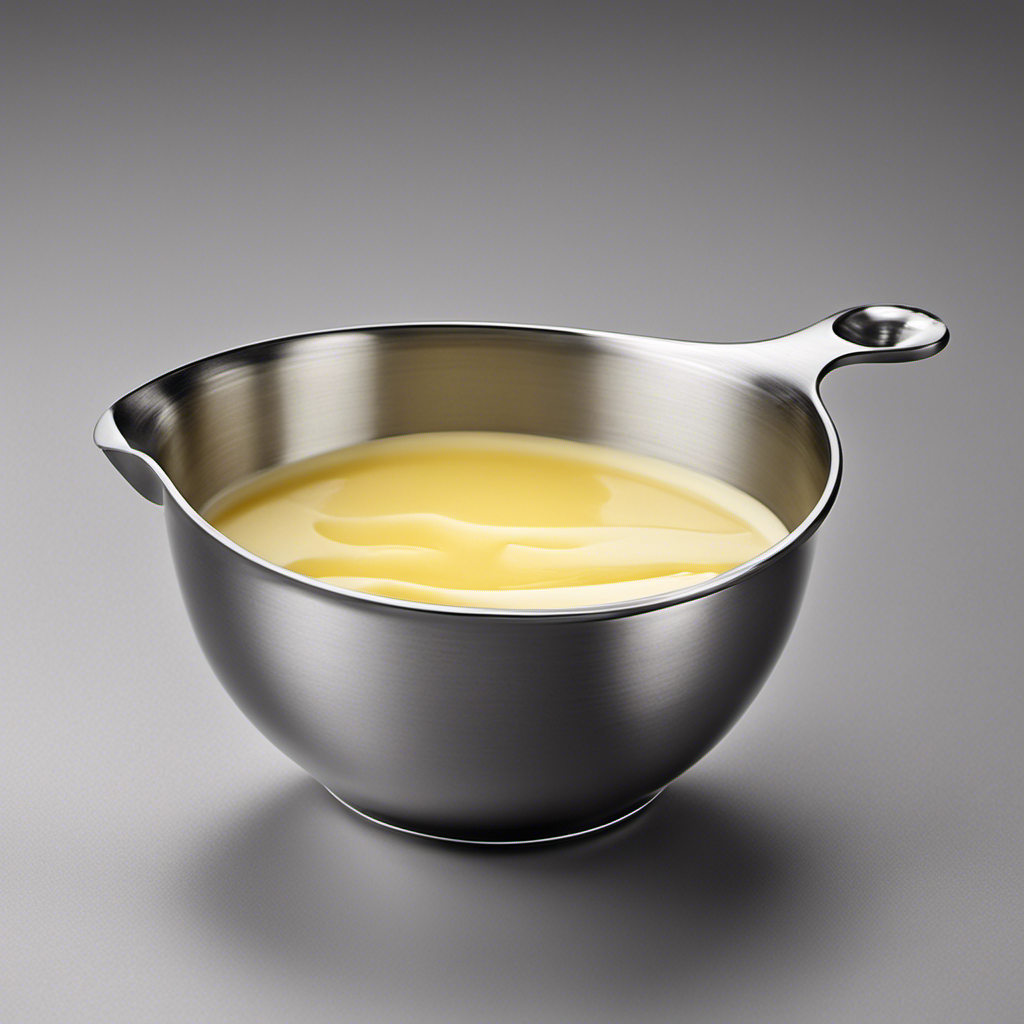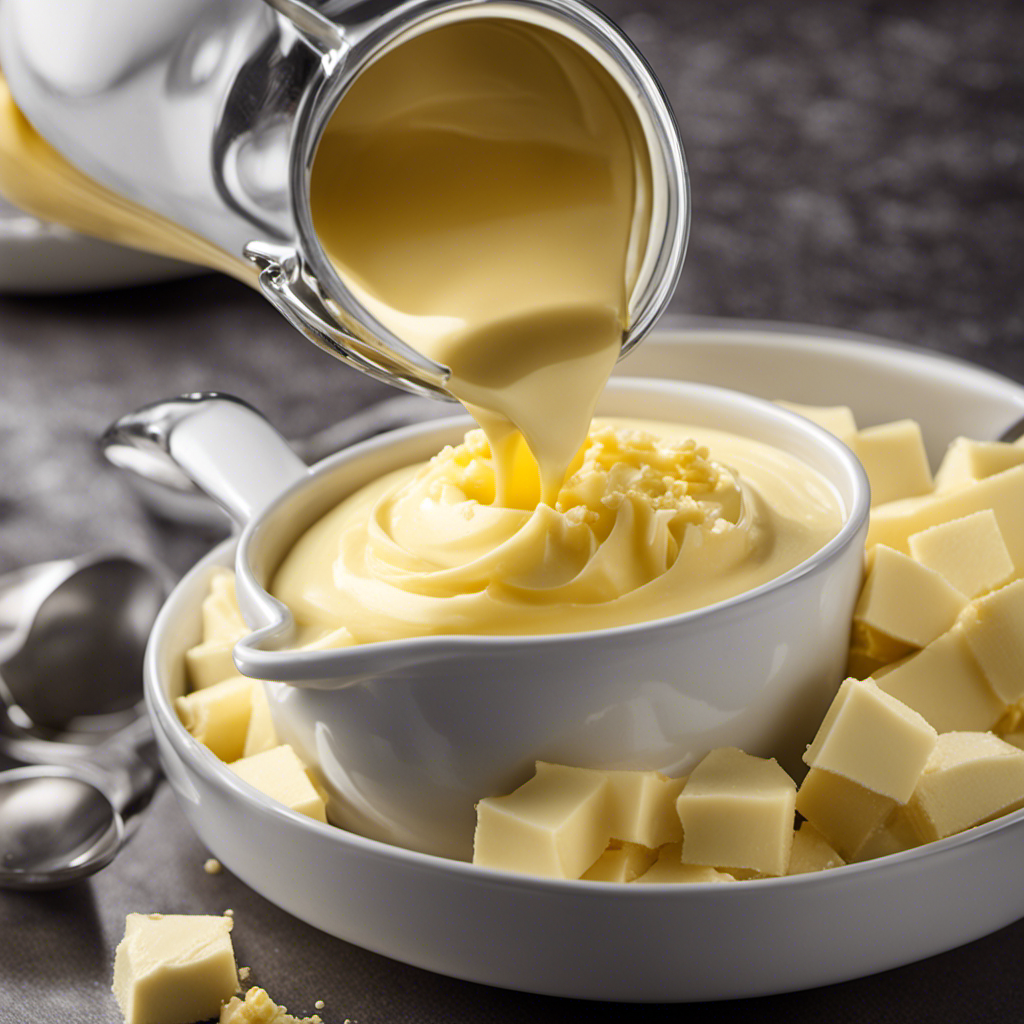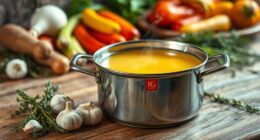I am here to demonstrate how to make a delicious garlic butter using the power of garlic powder. Get prepared to excite your taste buds with this easy yet flavorful recipe.
With the perfect blend of creamy butter and aromatic garlic powder, this homemade condiment will elevate any dish to new heights.
So, grab your apron and let’s dive into the world of garlic-infused deliciousness.
Key Takeaways
- Garlic powder provides a concentrated and convenient way to add garlic flavor to garlic butter.
- Select high-quality, creamy butter made from high-quality cream for the perfect garlic butter recipe.
- Garlic powder enhances the flavor of butter and adds a rich and creamy texture to dishes.
- Incorporate garlic powder into softened butter at room temperature and thoroughly mix to avoid clumps before letting it sit to enhance flavors.
The Benefits of Using Garlic Powder in Garlic Butter
Using garlic powder in your garlic butter is a great choice because it provides a concentrated and convenient way to add the delicious flavor of garlic to your dishes.
When it comes to garlic butter, the debate between garlic powder and fresh garlic is a common one. While fresh garlic offers a strong and pungent flavor, garlic powder has its own unique advantages.
One major benefit of using garlic powder is its ability to evenly distribute the garlic flavor throughout the butter. This ensures that every bite is infused with that irresistible garlic taste.
Additionally, garlic powder has a finer texture compared to fresh garlic, which can help create a smoother and creamier consistency in your garlic butter.
Selecting the Perfect Butter for Your Garlic Butter Recipe
When selecting the perfect butter for your recipe, you’ll want to go for a high-quality, creamy option. The butter you choose will greatly impact the flavor and texture of your garlic butter.
Look for butter that is made from high-quality cream and has a rich, smooth consistency. Opt for unsalted butter, as it allows you to control the amount of salt in your recipe. Additionally, consider using cultured butter for a tangy flavor profile.
While garlic butter is traditionally used as a spread or topping for bread, it can also be used in various other dishes. Try melting it over grilled vegetables, tossing it with pasta, or using it as a base for sautéing shrimp.
Get creative and experiment with different ways to incorporate garlic butter into your cooking. The possibilities are endless!
The Role of Garlic Powder in Enhancing the Flavor of Butter
When it comes to butter, there are three key points that make it a must-have ingredient in any kitchen: its ability to intensify the taste of dishes, its convenience and versatility, and its long shelf life.
Butter has a way of elevating the flavors of both sweet and savory dishes, adding a rich and creamy texture that is hard to resist. Whether you’re using it in baking, cooking, or simply spreading it on toast, butter is a go-to ingredient that enhances the taste of any dish.
Additionally, butter’s long shelf life makes it a practical choice for stocking up your pantry, ensuring that you always have a tasty and versatile ingredient on hand.
Intensifying Butter’s Taste
To make your butter’s taste even more flavorful, try adding a pinch of salt to intensify the flavor. Salt has the power to enhance the natural taste of ingredients, and when combined with butter, it can truly elevate the overall flavor profile.
Here are four culinary uses for salted butter that will leave your taste buds craving for more:
-
Baking: Salted butter adds depth and complexity to baked goods like cookies and cakes. It balances the sweetness and brings out the flavors of other ingredients.
-
Sauteing: When cooking savory dishes, using salted butter can help bring out the natural flavors of vegetables, meats, and seafood. It adds a rich and savory element to your dishes.
-
Spreading: Salted butter is perfect for spreading on toast or bagels. The hint of salt enhances the taste of your breakfast and adds a delicious kick.
-
Seasoning: By incorporating salted butter into your sauces, gravies, and dressings, you can create a well-rounded and flavorful base for your dishes.
Convenience and Versatility
Salted butter is a versatile ingredient that can enhance the flavor of a variety of dishes. Its convenience and flavor enhancement make it a staple in my kitchen.
Whether I’m sautéing vegetables, spreading it on warm bread, or using it as a base for sauces, salted butter adds richness and depth to my meals. I love how it effortlessly melts into a golden pool, coating every ingredient with its creamy goodness.
Its salty notes balance out the sweetness in desserts, while also amplifying the savory flavors in savory dishes. With just a simple pat or scoop, salted butter can transform an ordinary dish into something extraordinary.
It’s the secret ingredient that elevates my cooking and keeps me coming back for more.
Long Shelf Life
When it comes to garlic butter, one of the key factors to consider is its shelf life. After all, you want to be able to enjoy the delicious flavors of garlic for as long as possible. Fortunately, using garlic powder as a substitute can help preserve that garlic flavor while extending the shelf life of your garlic butter.
Here are some tips on how to preserve the garlic flavor in your butter using garlic powder substitutes:
-
Use roasted garlic powder: This adds a rich and nutty flavor to your butter, similar to freshly roasted garlic cloves.
-
Try granulated garlic: With a coarser texture, this substitute provides a more pronounced garlic flavor.
-
Experiment with garlic salt: This combination of garlic powder and salt adds both flavor and seasoning to your butter.
-
Consider garlic oil: Infusing garlic oil into your butter not only adds flavor but also helps preserve the garlic taste for longer.
Step-by-Step Guide to Making Garlic Butter With Garlic Powder
First, I mix together softened butter and garlic powder in a small bowl.
Using fresh garlic in garlic butter has numerous benefits. It adds a strong and aromatic flavor that enhances the taste of any dish. Fresh garlic also contains allicin, a compound known for its antimicrobial and antioxidant properties.
On the other hand, when comparing garlic powder and garlic salt in garlic butter, there are some differences to consider. Garlic powder is made from dehydrated garlic cloves and provides a more concentrated flavor, while garlic salt combines garlic powder with salt, providing a salty and garlicky taste. Both options can be used in garlic butter, depending on personal preference.
After thoroughly mixing the butter and garlic powder, I can’t wait to spread it on warm bread or melt it over some grilled shrimp. The possibilities are endless with this flavorful and versatile garlic butter.
Important Tips for Properly Incorporating Garlic Powder Into Butter
To properly incorporate garlic powder into your butter, you should start by ensuring that the butter is softened and at room temperature. This will make it easier to mix the garlic powder evenly throughout the butter. Here are some important tips to keep in mind:
1) Use the right amount: Start with a small amount of garlic powder and gradually add more to taste. Remember, a little goes a long way.
2) Mix well: Use a fork or a spoon to thoroughly mix the garlic powder into the butter. Make sure that there are no clumps or pockets of garlic powder left.
3) Let it sit: After mixing, let the garlic butter sit for about 10-15 minutes. This will allow the flavors to meld together and enhance the taste.
4) Garlic powder substitutions: If you don’t have garlic powder on hand, you can substitute it with fresh minced garlic or garlic paste. Just keep in mind that the flavor intensity may vary.
Alternative uses for garlic powder: Apart from making garlic butter, you can also use garlic powder to season roasted vegetables, grilled meats, and pasta dishes. It adds a delicious savory flavor to any dish.
The Science Behind the Flavor Profile of Garlic Butter With Garlic Powder
The flavor profile of garlic butter with garlic powder is enhanced by the combination of savory garlic and creamy butter. But did you know that garlic powder also plays a role in the texture of this delicious spread?
When garlic powder is added to butter, it absorbs the moisture and releases its flavor. This absorption causes the butter to become slightly thicker and creamier, creating a smooth and velvety texture that is perfect for spreading on bread or melting over vegetables.
Now, let’s dive into the chemical process behind the flavor development in garlic butter with garlic powder. When the garlic powder is mixed with the butter, the compounds responsible for the distinct aroma and taste of fresh garlic undergo a transformation.
The sulfur compounds in garlic powder react with the fat molecules in the butter, creating new compounds that give garlic butter its unique and mouthwatering flavor. So, next time you indulge in some garlic butter with garlic powder, remember the science behind its deliciousness and savor every bite.
Adding Other Herbs and Spices to Elevate Your Garlic Butter
When you’re looking to elevate your garlic butter, don’t forget to experiment with different herbs and spices. Adding fresh herbs can bring a burst of flavor to your garlic butter and take it to a whole new level. Here are some creative garlic butter variations to try:
-
Rosemary and Thyme: These aromatic herbs add a refreshing and earthy flavor to your garlic butter. Perfect for spreading on crusty bread or using as a marinade for grilled meats.
-
Basil and Parmesan: This combination creates a deliciously cheesy and herbaceous garlic butter. It’s great for tossing with pasta or drizzling over roasted vegetables.
-
Cilantro and Lime: Give your garlic butter a zesty kick with the addition of fresh cilantro and tangy lime juice. This variation goes well with seafood dishes or as a topping for grilled corn.
-
Smoked Paprika and Cumin: For a smoky and slightly spicy twist, try adding smoked paprika and cumin to your garlic butter. It’s perfect for adding a kick to grilled meats or roasted potatoes.
Different Ways to Use Garlic Butter Made With Garlic Powder
Experimenting with various seasonings and spices can transform your garlic butter made with garlic powder into a versatile and flavorful addition to your favorite dishes. Not only does it add a garlicky punch, but it also brings a rich and creamy texture to any recipe.
There are countless possibilities for using garlic butter in different recipes. For a quick and easy option, spread it on warm bread or rolls for a delicious garlic bread. Another idea is to toss it with pasta for a simple yet satisfying meal. You can also use it to sauté vegetables or drizzle it over grilled meats for an extra burst of flavor.
The possibilities are endless! So go ahead and get creative with your garlic butter, and discover new ways to enhance your favorite dishes.
Storing Garlic Butter With Garlic Powder for Future Use
When it comes to making garlic butter with garlic powder, it’s important to know how to properly store it for future use. Using proper storage techniques can help extend its shelf life and ensure that it remains fresh and flavorful.
In this discussion, I will share some tips on how to store garlic butter with garlic powder to maximize its longevity and preserve its delicious taste.
Proper Storage Techniques
To keep your garlic butter fresh for longer, store it in an airtight container in the refrigerator. Proper storage techniques are essential for maintaining the freshness and flavor of garlic butter.
Here are some tips to help you store your garlic butter properly:
-
Choose the right container: Use an airtight container to prevent air and moisture from entering, which can cause the butter to spoil.
-
Refrigerate promptly: Place the garlic butter in the refrigerator as soon as possible after making it to slow down bacterial growth and maintain its freshness.
-
Label and date: Always label the container with the date you made the garlic butter to keep track of its freshness.
-
Use within a week: Garlic butter is best consumed within a week to ensure optimal taste and quality.
By following these proper storage techniques, you can enjoy fresh and flavorful garlic butter for longer.
Now, let’s explore how to extend its shelf life even further.
Extended Shelf Life
Now that we’ve covered proper storage techniques for garlic butter, let’s talk about how to extend its shelf life.
Preserving freshness and enhancing longevity are key to ensuring that your garlic butter stays delicious for as long as possible.
One effective method is to store your garlic butter in an airtight container in the refrigerator. This will help maintain its flavor and prevent any unwanted odors from seeping in. Additionally, you can also freeze your garlic butter for even longer preservation. Simply portion it out into smaller containers or ice cube trays and store them in the freezer.
By taking these steps, you can enjoy your homemade garlic butter for weeks or even months.
But what if you want to adjust the amount of garlic powder in your recipe? Well, don’t worry! Expert advice on adjusting the garlic powder amount in your recipe is just around the corner.
Expert Advice on Adjusting the Garlic Powder Amount in Your Recipe
If you’re unsure about how much garlic powder to use in your recipe, an expert suggests starting with a smaller amount and adjusting to taste. This way, you can control the flavor and ensure it complements your dish perfectly.
Here are some tips on adjusting the garlic powder amount in your recipe:
-
Start with a pinch: Begin by adding a small amount of garlic powder, such as a pinch or a quarter teaspoon. This allows you to gauge the initial flavor impact and make adjustments accordingly.
-
Taste and assess: After adding the initial amount, taste your dish. Pay attention to the intensity of the garlic flavor. If it’s too mild, you can gradually increase the amount. If it’s overpowering, you can dilute it with other ingredients.
-
Add in increments: Instead of adding a large amount at once, sprinkle the garlic powder in small increments. Taste after each addition to ensure you achieve the desired flavor.
-
Consider cooking techniques: Keep in mind that the cooking technique you’re using can affect the garlic powder’s flavor. For example, if you’re sautéing the dish, the garlic flavor may mellow out and become more subtle.
Frequently Asked Questions About Making Garlic Butter With Garlic Powder
One common question is how long the homemade garlic butter with garlic powder can be stored. Well, let me tell you, homemade garlic butter is a delicious and versatile addition to any kitchen. It’s perfect for spreading on bread, slathering on grilled meats, or even tossing with pasta.
As for how long it can be stored, I recommend keeping it in an airtight container in the refrigerator. This will help preserve its freshness and flavor for up to two weeks.
Now, if you’re out of garlic powder and need a substitute, fear not! You can use minced fresh garlic or garlic salt instead. And if you’re looking for alternative uses for garlic powder, sprinkle it on roasted vegetables, add it to soups and stews, or even mix it into homemade salad dressings. The possibilities are endless!
Frequently Asked Questions
Can I Use Fresh Garlic Instead of Garlic Powder in the Recipe?
Sure, you can definitely use fresh garlic instead of garlic powder in the recipe. The taste of fresh garlic will be more pronounced and flavorful compared to garlic powder.
How Long Will Garlic Butter With Garlic Powder Last in the Refrigerator?
The shelf life of garlic butter with garlic powder in the refrigerator depends on storage conditions. However, it’s important to note that freshness is key, so it’s best to consume it within a week for optimal flavor.
Can I Use Margarine or a Substitute for Butter in the Recipe?
Yes, you can use margarine or a substitute for butter in the garlic butter recipe. Margarine can be a good alternative and offers a different flavor profile. Substitutes for butter can also provide health benefits.
Can I Adjust the Amount of Garlic Powder to Make the Flavor Milder or Stronger?
Sure, you can definitely adjust the amount of garlic powder to control the flavor intensity. Adding more will make it stronger, while reducing the amount will make it milder. Experiment and find your perfect balance!
Can I Freeze Garlic Butter With Garlic Powder for Long-Term Storage?
Yes, you can freeze garlic butter with garlic powder for long-term storage. Freezing helps to preserve its flavor and texture. However, using fresh garlic in recipes provides a more vibrant taste and aroma.
Conclusion
After exploring the benefits and process of making garlic butter with garlic powder, it’s clear that this theory holds true.
The use of garlic powder enhances the flavor of butter, creating a delicious and versatile condiment. Whether you’re spreading it on bread, using it to cook meat or vegetables, or simply adding it to your favorite recipes, garlic butter made with garlic powder is a game-changer.
So, go ahead and try it for yourself, and prepare to be amazed by the burst of flavor that awaits you.
